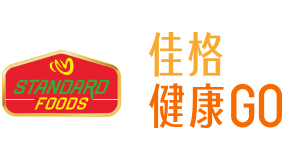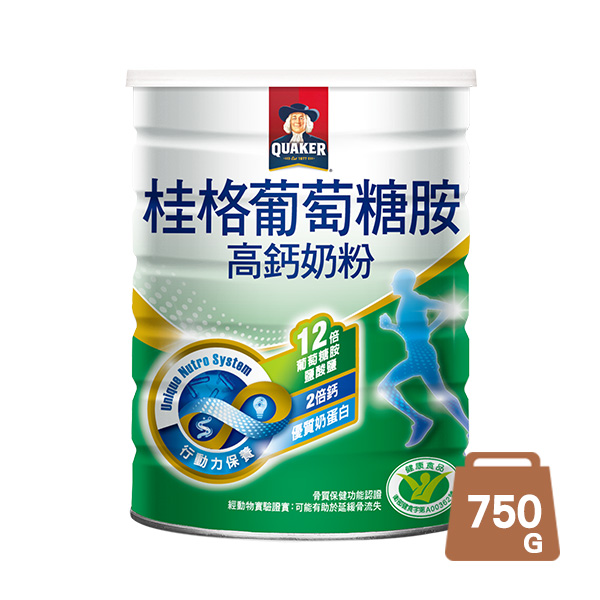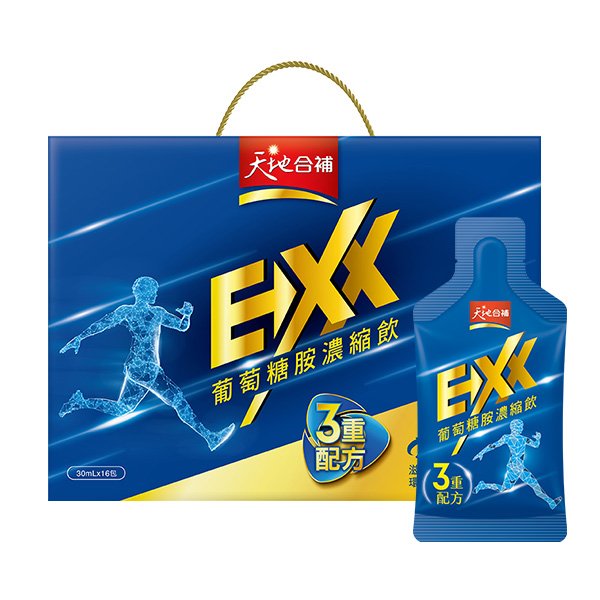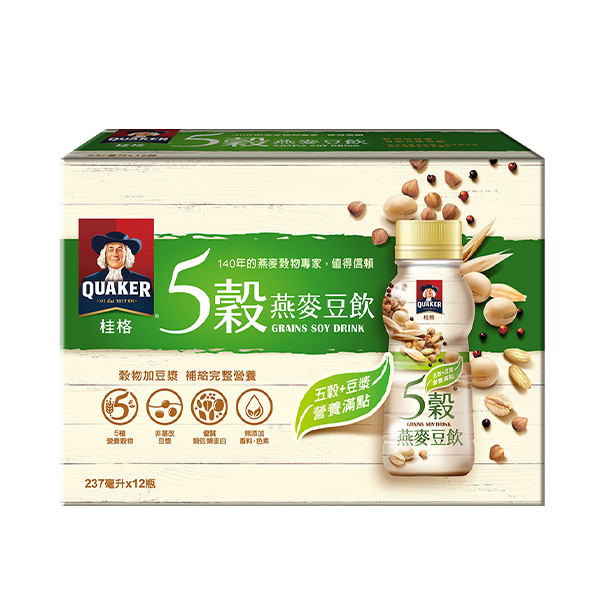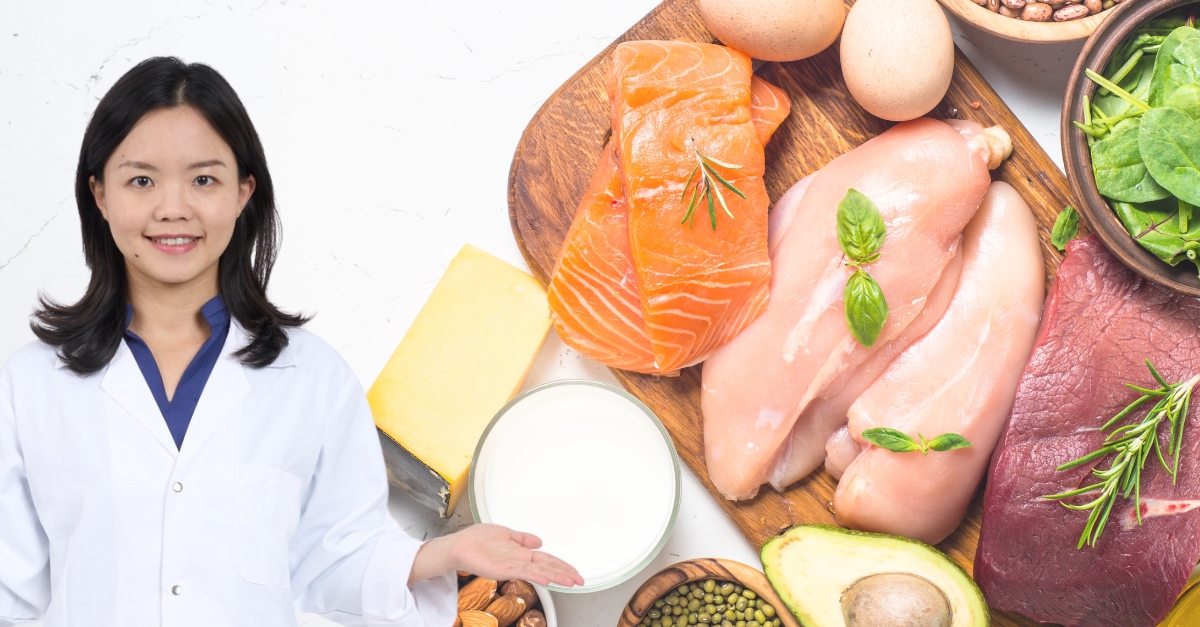
健身打底飲食完整攻略-3大原則&營養師推薦的10種蛋白質食物
我們每個人應該都有肚子咕嚕咕嚕叫,所以趕快跑到便利商店去買個茶葉蛋來吃的經驗,這其實是個很聰明的選擇,因為茶葉蛋小小一顆裡,有蛋白質及多種營養素,讓你可以快速補充能量!蛋白質有很多好處,但為什麼它常常又被叫作生命最基本的「原料」呢?
在這篇文章中,我們會把蛋白質從上到下、從左到右,解釋得清清楚楚,這篇文章中,我們會帶你看健身打底飲食的3大原則,並和你分享我們營養師推薦的10種有蛋白質的蔬食和肉類!往下滑看今天飲食可以多加什麼!
=★佳格營養師介紹★=
★打底飲食 3 大原則
不是上健身房就可以了,在健身房外,還要有完善的飲食計劃,確保你有得到足夠的重要營養素。我們會在這個部分幫你分析打底飲食的核心原則、了解怎麼平衡各種營養素的攝取才能順利提升健身成果或運動成效!不管你是新手還是老手,這些原則都適合你參考,調整自己的營養攝取來有效達到目標。
第 1 大原則:蛋白質用力加下去!
我們認識了蛋白質的好處後,接下來第一步就是要確認自己目前到底有攝取多少蛋白質,再把那個數值往上加。
而最簡單的方法,就是早餐吃優質蛋白鹹食!
第 2 大原則:複合型碳水化合物吃起來!
除了蛋白質,還要確保有別的熱量來源,像是碳水化合物,讓你做高強度運動的時候有足夠的能量。
你的熱量來源應該要有很多蔬菜水果、非精製穀物等複合型碳水化合物,讓精神可以更穩定地維持一整天。
第 3 大原則:知道要吃多少蛋白質才夠
決定每天應該吃多少蛋白質要考慮到許多因素:年齡、體重、活動量⋯⋯等等。
所以我們簡化一下,直接來看台灣衛生福利部國民健康署 ( 國健署 )的建議:19 ~ 71 歲的人,建議的蛋白質攝取量是 60 ~ 70 公克。
如果真的想要更精準的數值的話,把自己體重數(公斤)x 1.2 ~ 2.2,就可以得到適合你的蛋白質攝取區間(公克),然後再根據個人健身強度和目標調整。
想要再更深入了解要怎麼打造最適合自己的飲食,可以來看這篇健身時飲食和營養的三大原則,以及如何均衡配置不同的營養素,讓你增肌更順利!
★植物蛋白還是動物蛋白比較好?
感覺這已經是萬年問題了!很多人選擇植物蛋白,是因為大規模的畜牧業常被認為是全球暖化的元兇之一,但也有些人會懷疑:想要增肌、健身,不吃動物、不吃動物蛋白,改吃植物蛋白真的會有效嗎?
其實很多實驗已經證實素食、蔬食、全植飲食是可以提供足夠的蛋白質的,但對有些人來說,巷口的培根蛋餅畢竟是每天不可放棄的小確幸呀 ( ; ω ; )
改變飲食其實不是那麼容易的事,有很多面向的因素都要考慮到,我們幫你分析了植物蛋白、動物蛋白分別的利弊讓你參考,選擇最適合你的目標、價值的飲食方式。
★佳格營養師推薦的高優質蛋白食物
不管你決定蛋白質要從哪裡來,選擇優質蛋白都是很重要的,尤其有在健身的話,蛋白質更是重要。
我們列了 5 個植物蛋白食物來源、 5 個動物蛋白食物來源,也列出它們各自的營養成分,讓你可以健康變巨巨。
以下的營養成分資訊都是取自台灣的衛福部食藥署網站,你也可以上這個網站查查看自己平常吃的食物的熱量、營養素、微量礦物質。
營養師推薦的 5 種蛋白蔬食
以下這些食物中都有優質蛋白質,而且便宜、種類豐富,讓你健身的時候可以吃得更營養、健康。
藜麥:
藜麥中的蛋白質是完全蛋白、有 9 種所有我們人體沒有辦法自己製造的必需胺基酸。
藜麥同時富含膳食纖維,可以幫助消化,也因為它很容易就能吸收各種調味或其他食物的味道,也很適合加入各種的料理中。
每 100 公克的藜麥有:
5 公克的蛋白質
143 大卡
2.22 公克的脂肪
豆腐:
豆腐是植物性蛋白來源,而且它容易吸收各種風味,各種香料或其他食物的味道可以很容易吸附在豆腐上,是餐桌上少不了的食材。
豆腐可以被加工成各種形式,所以它很常出現在各國的料理中,常見的形式有:凍豆腐、嫩豆腐、臭豆腐、炸豆腐、豆皮絲⋯⋯等等。
每 100 公克的豆腐有:
8 公克的蛋白質
70 大卡
4 公克的脂肪
燕麥:
想到蛋白質通常不會馬上想到燕麥,但其實燕麥是植物性蛋白來源,同時也富含膳食纖維,讓吃完燕麥後,可以更穩定並持久地提供能量。
日常想吃燕麥,可以試試看桂格機能燕麥片!
每 100 公克的燕麥有:
17 公克的蛋白質
370 大卡
6.9 公克的脂肪
希臘優格(無脂、無調味):
希臘優格的蛋白質根本多到爆棚,它同時也富含益生菌,可以幫助消化、協助維持消化道機能,吃起來滑順又濃郁。
每 100 克的希臘優格有:
4 公克的蛋白質
117 大卡
9 公克的脂肪
杏仁:
杏仁不僅有蛋白質、營養成分豐富,同時有纖維和優質的脂肪,讓你可以吃得滿足,又能守護健康!
吃杏仁的話,只要遵守 1-2-3 原則:1 天最多吃 23 公克的杏仁,這樣大約是 4 ~ 5 公克的蛋白質、大約 140 大卡、11 公克的脂肪。
每 100 公克的杏仁中有:
19 公克的蛋白質
193 大卡
11 公克的脂肪
營養師推薦的 5 種優質蛋白肉類
去皮雞胸肉:
沒有列到雞胸肉的蛋白質食物清單都不叫蛋白質食物清單!
雞胸肉有的飽和脂肪極少、可以做出的料理更是百百種,而且和其他脂量較高的部位相較之下,絕對是更健康的選項。
每 100 公克的去皮雞胸肉有:
22.4 公克的蛋白質
104 大卡
0.9 公克的脂肪。
蛋:
優質蛋白、完全蛋白、必需胺基酸全都有。
除了是懶人食物,也可以是懶人配料,任何一道料理加顆蛋感覺都 OK。
每 100 公克的蛋有:
13 公克的蛋白質
147 大卡
9 公克的脂肪
一顆蛋大概是 50 ~ 70 公克,所以 100 公克的蛋就是 1.5 ~ 2 顆蛋。
瘦牛肉 ( 如:沙朗 )
牛身上脂肪比較少、比較瘦的部位同時也有重要的營養素鐵和鋅,可以促進許多不同的生理機能。
每 100 公克的瘦牛肉有:
27 公克的蛋白質
250 大卡
10 公克的脂肪
鮭魚 ( 或其他油脂含量高的魚 ):
鮭魚不只有蛋白質,它還含有很健康的 Omega-3 脂肪酸,讓你增加肌肉也守護健康!
每 100 公克的鮭魚有:
25 公克的蛋白質
206 大卡的熱量
13 公克的脂肪
水煮鮪魚罐頭
低脂、便宜、實用、快速,任何一餐加個水煮鮪魚就是個好的健身餐了!
每 100 公克的水煮鮪魚有:
30 公克的蛋白質
116 大卡的熱量
1 公克的脂肪
★只要有蛋白質就好了嗎?
如果是這樣的話,每個路人都可以是健身巨巨了⋯⋯才沒這麼簡單!增肌還要攝取另外兩種營養素:脂肪、複合型碳水化合物
碳水化合物、脂肪的來源也要慎選,畢竟它們是要提供健身鍛鍊必要的能量,還有身體需要的重要營養素。
營養師推薦的 5 種含碳水化合物和脂肪的健身打底食物
想要健身打底好體質的話,要有高品質碳水化合物和脂肪,因為它們可以提供健身鍛鍊必要的能量和重要的營養素來維持健康。
複合型碳水化合物有幾個重要的功能:讓好精神更持久、提供健身 / 運動的能量。
而健康的優質脂肪可以維持關節健康,讓運動過程更順利!
地瓜:
幾乎所有超商都有賣,在台灣根本沒有吃不到地瓜的理由!所以你的健身打底飲食也沒有做不到的理由!
地瓜富含膳食纖維和各種營養素:鉀、維生素A、維生素C、多種的維生素B。
每 100 公克的地瓜有:
2 公克的蛋白質
86 大卡
1 公克的脂肪
20 公克的碳水化合物
糙米:
糙米屬於非精製穀物,富含膳食纖維及必需營養素如:錳、鎂、硒。
糙米比白飯健康這件事大家應該都知道,但是原因可能就講不太出來了——其實是因為糙米含更多的膳食纖維、消化的速度比較慢,也因此更協助可以維持血糖穩定。
如果你每次自助餐都選紫米或糙米的話,你一定會喜歡桂格免浸泡 10 超纖穀豆飯:我們精選 11 種超級穀物、豆類、種籽:燕麥、糙米、鷹嘴豆、蕎麥、紫米、紅扁豆、亞麻籽、黑芝麻、紅藜麥、發芽米,提供所有你需要的營養!
每 100 公克的糙米有:
2.7 公克的蛋白質
111 大卡
0.9 公克的脂肪
23 公克的碳水化合物
酪梨:
酪梨含單元不飽和脂肪酸、纖維、各種維生素及礦物質:鉀、葉酸、維生素 K。
每 100 公克的酪梨有:
2 公克的蛋白質
160 大卡
15 公克的脂肪
1.8 公克的碳水化合物
杏仁:
杏仁既是優質蛋白質也是優質碳水化合物!
它有含有高蛋白質、高膳食纖維、高優質脂肪,還提供各種必需營養素:維生素 E、鈣、鎂,適合當下午茶點心,讓你充飽電、好精神持續一整天!
每 100 公克的杏仁有:
19 公克的蛋白質
196 大卡
11 公克的脂肪
*22 公克的碳水化合物
橄欖油:
橄欖油含單元不飽和脂肪酸,這些脂肪酸中,油酸對健康特別有幫助,在均衡飲食的前提下,橄欖油中多種的抗氧化物(如:維生素 E)可以幫助降低疾病風險。
佳格旗下得意的一天頂級冷壓橄欖油從義大利原裝進口,適合搭配輕鬆無負擔的增肌飲食。
每 100 公克的橄欖油有:
884 大卡
100 公克的脂肪(主要是單元不飽和脂肪酸 )
0 公克的蛋白質
0 公克的碳水化合物
飲食加入這些食物就可以確保你不只有足夠的熱量,還有重要的營養素,讓你健身的過程中可以保持健康、活力充足!
蛋白質有可能吃太多嗎?
感覺我們一直在說「蛋白質好棒棒、萬萬歲」,你一定會想問:高蛋白飲食真的完全沒有問題嗎?蛋白質有沒有可能吃太多?
每天建議的蛋白質攝取量因人而異,美國蟬聯最佳醫院排名首位七年 ( 截至 2023 止 ) 的梅約醫學中心建議:
每天久坐、活動量不大的成人蛋白質攝取量 ( 公克 ) 為:體重 ( 公斤 ) x 0.8,所以一般女性的蛋白質建議攝取量是 46 公克,男性則是 56 公克。
簡單來說,如果沒有在健身的話,每天大概吃 2 個拳頭大的蛋白質就夠了。
當然,有在健身可以吃多一點蛋白質,但也不要太誇張,例如:一天吃 200 公克的蛋白質就有點太多了,如果你哪天吃了 200 的蛋白質,那一週其他天最好還是少吃一點蛋白質喔!
=★佳格營養師小筆記★=
有三種補充品可以幫你達到目標:蛋白質、葡萄糖胺、非變性第二型膠原蛋白(常以「UC2」、「UC II」的名字出現)。
我們攝取的卡路里值、營養會影響運動表現,這件事大家都很熟,所以通常都是在運動後補充蛋白質。
但其實運動前、運動後、睡前的營養補充也很重要,而且重點應該要擴大到將蛋白質跟其他營養素配合,才會是比較理想的營養補充模式。
佳格的研發部精心設計了適合健身、增肌的「健身打底 1500大卡基礎組」,裡面的四個產品就剛好幫你顧到運動前、後、睡前的營養補給。
營養補充時機也很重要!
增肌運動前補充 1:
運動的 3 ~ 4 個小時前:
建議飲食要均衡,碳水化合物選擇未精製的全穀雜糧,輔以優質蛋白質,創造營養的一餐,而且碳水化合物每公克可以提供 4 大卡的熱量,是最適合補充肌肉肝糖的來源。
運動的前 1 小時內:
建議不要空腹,要補充足夠的水分、吃好消化、低脂的食物,如:烤地瓜、燕麥飲、豆漿、豆奶、低脂牛奶⋯⋯等,才不會造成消化的負擔。
舉例來說,桂格的健身打底 1500大卡基礎組裡面的產品就很適合運動前吃,如果你做的是中、高強度的運動或耐力訓練,可以用以下的產品,讓你健身更有力!
桂格五穀燕麥豆飲適合作運動前的補充,而也它因為不含牛奶,所以素食、全植飲食、乳糖不耐的族群都可以放心用桂格五穀燕麥豆飲讓健身更加分!
它的五穀中含燕麥、藜麥、蕎麥、糙米、大麥,幫你充分補充纖維;再加上裡面的非基改豆漿,每罐裡只有 3.1 公克的脂肪,可以讓你運動前輕鬆、簡單、快速帶上充分能量、優質蛋白。
健身運動中補充:
運動中該補充多少熱量、營養要依運動的時間長度、強度而定。
如果要做超過 1 個小時的耐力訓練,最好要補充水分、礦物質、碳水化合物,才能補充運動時消耗掉的能量。
健身運動後補充原則:
運動後的營養補充,你主要可以注意三個面向:
1. 時機:要在適當的時間補充,才能發揮最大的效果
2. 補充什麼:均衡營養素、補充品
3. 主要目的:協助恢復能量
國際運動營養協會 ( International Society Of Sports Nutrition,ISSN ) 建議:運動後的 30 ~ 60 分鐘,碳水化合物 : 蛋白質補充的比例最好是 3 ~ 4 : 1。
而蛋白質最好選擇含必需胺基酸的優質蛋白質食物,像:雞蛋、去皮雞胸、豆漿、豆奶、魚、乳清蛋白、酪蛋白⋯⋯等等。
運動後補充 :1.均衡優質蛋白、複合型碳水化合物
健身後用可以桂格完膳全新均衡粉配方,它的碳水化合物、蛋白質比正好符合國際運動營養學會建議的運動後營養素補給比例。
桂格完膳全新均衡粉配方不僅用濃縮乳清蛋白給你優質蛋白、協助修復,更含多元不飽和脂肪酸與中鏈三酸甘油酯加強能量補充,再用維生素 C、D、B1、B2、鈣、鐵⋯⋯ 30 多種營養素。
運動後補充 :2.葡萄糖胺
運動後會累通常是因為肌肉痠痛、發炎,而已經有很多研究探討營養素、功效物質對改善這些症狀的效果,如:維生素 C、維生素 D、蛋白質、特定胺基酸、多酚類物質。
許多實驗也有討論補充葡萄糖胺對運動員膝蓋軟骨的保護效果做研究,有些研究也針對有膝關節炎的銀髮族在運動之外補充葡萄糖胺、軟骨素,對緩解疼痛的助益。
佳格的天地合補 EXX 葡萄糖胺濃縮飲每包含 1500 毫克的葡萄糖胺鹽酸鹽。它還添加第二型膠原蛋白、軟骨素,調節生理機能、減少運動負擔。
睡前補充:優質酪蛋白
國際運動營養協會建議在睡前補充酪蛋白,讓吸收較緩慢的酪蛋白可以在我們休息的時候協助肌肉合成。
而牛奶中的蛋白有大約 80% 是酪蛋白,不僅可以補充鈣質、其中更有多元優質蛋白,桂格的葡萄糖胺高鈣奶粉又有 2 倍鈣質,就很適合在睡前喝喔!
這個葡萄糖胺高鈣奶粉也含維生素 D、K,可以促進鈣質吸收、強化骨質。經過國家健康食品、骨質保健功能認證,可能有助於延緩骨質流失。
★結論
健身打底飲食要考慮到的面向非常多,恭喜你已經走出第一步,開始查資料、做功課了!
關鍵不只有蛋白質,還有碳水化合物、脂肪,它們怎麼搭配、什麼時間吃、怎麼補充營養素或關鍵物質⋯⋯。
我們在這篇文章列了 10 種優質蛋白食物來源(5 種植物蛋白、5 種動物蛋白)、5 種好的碳水化合物、2 種補充品。這個週末就來試試,其中一餐多加一樣這份清單裡的食物吧!
你也可以參考我們的另外一篇文章,佳格的營養師有更詳細地解釋如何在增肌的過程使用這些產品,也幫你設計了增肌飲食一日菜單,示範食物搭配給你看喔!
只要堅持你的健身計劃、確保均衡充實的營養、遵循可信的資料來源,你就可以踏上充滿力量、健康、活力的道路。
祝你增肌更上一層樓!
<免責聲明>:本文章僅供參考,並不是專業的醫療建議,如果你有任何疑慮或特殊的身體狀況,請在食用補充品或補充劑或改變飲食習慣前諮詢專業醫療人員。

The Complete Guide to Your Muscle-gaining Diet – Everything you Need to Know Plus 10 High-protein Foods Recommended by Our Dietitian
You’ve probably heard your stomach growl, rushed into 7-11 to grab a quick snack, and walked out with a tasty tea egg. That’s a wise choice as it gives you a burst of energy, is easy to eat on the go, and it’s easy on the pocket. But the best takeaway is it packs a lot of protein into a quick bite. And protein, as you’ll come to find out, is a powerhouse macronutrient that can fuel your day!
In this article, we discuss all aspects of a protein, and how important it is if you’re aiming to build muscle. We discuss the principles of a muscle-building diet, the benefits of protein, and the differences between plant and animal proteins. We also offer 10 high-protein food sources: 5 that are plant-based and 5 that are animal-based. Let’s go!
Introducing our Nutritionist
Amanda Ho graduated from Taipei Medical University's Institute of Health and Nutrition. She worked for several years as a clinical nutritionist at Chang Gung Hospital, Taipei. She has assisted in developing specialized formula foods for specific diseases and has also co-authored books on cancer diets. Amanda aims to help everyone understand their health better and lead a more fulfilling and satisfying life.
3 Principles of a Muscle-Building Diet
Building lean muscle requires more than just lifting weights; it demands a well-structured diet that provides the essential nutrients for growth and repair.
Whether you're a novice protein-lover, a seasoned gym-goer, or just interested in improving your energy, these principles will help you tailor your nutrition to achieve your muscle-building goals effectively.
1st Principle: Pump up the Protein
Now that you know how beneficial protein is, the first step is to find out how much protein you are currently consuming. The second step is to increase your protein intake.
One simple way of adding protein to your diet is making sure your breakfast is savory and high-protein.
2nd Principle: Cram in those Complex Carbohydrates
Protein intake: check. But that’s not all. You also need other calorie sources. Carbohydrates play a crucial role in providing energy for intense workouts and replenishing glycogen stores in muscles.
Complex carbohydrates like whole grains, fruits, and vegetables should make up a significant portion of your calorie intake, promoting sustainable energy levels throughout the day.
3rd Principle: Know How Much to Eat to Build Muscle
Determining the appropriate protein intake varies is based on factors such as age, weight, and physical activity level. However, to keep things simple, let’s go according to the Taiwan National Health Service. According to their data, the recommended daily allowance (RDA) for protein is approximately 60-70 grams of protein for anybody 19-71 years old.
If you want a more precise measurement, you can also calculate having 1.2 to 2.2 grams of protein per kilogram of body weight daily. This amount can also be adjusted depending on your training intensity and goals.
If you’re interested in learning more about the three core principles, this article provides more in-depth information about them and this one discusses how to strike the right balance with other nutrients to optimize your muscle-building journey.
Plant VS Animal Protein: Which is a Better Source?
Ah, the classic discussion around many a dinner table is still ongoing. In a world that struggles with over farming and over population, some are reconsidering their diets as they factor in the environmental impact of big farming. Many are wondering if there would be a real difference switching from meat to plant-based proteins, especially if muscle gain is the goal.
While studies show that a plant-based diet supplies more than enough protein, some people can’t imagine a life without bacon. Choosing to change your diet is not a simple choice as there are many personal factors to consider. This is why we have an article that examines the benefits and drawbacks of plant and animal protein source that can help you make a choice that supports your goals and beliefs. Take a look at the list we provide and see if they sway your dietary choices.
High-Quality Protein Sources, as Recommended by our Nutritionist
Regardless whether you choose to eat meat or just limit your intake, or cut out animal-based foods, the quality of the protein you consume plays a vital role, especially of you are endeavoring to build muscle. To make things a little easier for you, we offer 5 plant-based and 5 meat-based high-quality protein sources, each offering a unique nutritional profile to support your muscle-building goals.
All of the nutritional information below is from the official Taiwan Food and Drug Administration website, where you can check your food sources to find out more about each one’s calories, macronutrients, and trace minerals.
5 Recommended Plant-based High-protein Foods
These high-quality protein sources are easy on the pocket and offer a diverse range of options if you are looking to optimize your muscle-building nutrition while maintaining overall health and well-being.
Quinoa:
Quinoa is a complete protein source, meaning it contains all nine essential amino acids. It’s easy to cook, absorbs flavor well, and is an excellent choice for those seeking plant-based protein options. It also has a lot of great dietary fiber to help with digestion.
For every 100 grams of quinoa:
5 grams of protein
143 kcal
2.22 grams of fat
Tofu:
Tofu is a plant-based protein that is prized for its ability to absorb flavors. A staple in many people’s diets, tofu is a truly versatile shapeshifter. From shredded tofu skin and silken tofu, to deep fried, stinky, or frozen tofu, this simple ingredient can surprise you with its many adaptations.
For every 100 grams of tofu:
8 grams of protein
70 kcal
4 grams of fat
Oats:
While not immediately thought of as a protein source, oats provide a surprising amount of protein. This humble grain is an excellent source of plant-based protein and is rich in dietary fiber, offering sustained energy and supporting muscle recovery.
For every 100 grams of oats:
17 grams of protein
370 kcal
6.9 grams of fat
Greek yogurt (plain, non-fat):
Greek yogurt is a protein powerhouse. It's also a great source of probiotics, which aid digestion and promote gut health. It’s creamy and tastes decadent.
For every 100 grams of Greek yoghurt:
4 grams of protein
117 kcal
9 grams of fat
Almonds:
Almonds are a nutritious source of protein and are also packed with healthy fats and fiber, making them a satisfying and heart-healthy protein option.
With almonds, think 1-2-3. In 1 day, have 23 almonds max. For 23 almonds you get about 4-5 grams of protein, around 140 calories, and 11 grams of fat.
OK, so, you definitely shouldn’t eat 100 grams of almonds (that’s around 140 almonds) in one sitting as that would be a fiber overload. But to keep the numbers consistent, here you go:
For every 100 grams of almonds:
19 grams of protein
193 kcal
11 grams of fat
5 Recommended Meat-based High-protein Foods
Chicken breast (without skin):
No meat-based protein list is complete without the humble chicken breast: it is tried, true, and tested. The chicken breast contains minimal saturated fat and is a healthier choice compared to fattier cuts of meat. It is also incredibly versatile in the kitchen, making it suitable for a wide range of dishes.
For every 100 grams of chicken breast (without skin):
22.4 grams of protein
104 kcal
0.9 grams of fat
Eggs:
Eggs are an excellent source of high-quality protein and provide all the essential amino acids needed for muscle repair and growth. Also very versatile, you can add an egg to almost dish.
One egg is between 50 and 70 grams so two eggs is equal to about 100 grams. For every 100 grams of eggs:
13 grams of protein
147 kcal
9 grams of fat
Lean beef (e.g., sirloin):
Lean cuts of beef, such as sirloin, are also rich in essential nutrients like iron and zinc, which support overall health.
For every 100 grams of lean beef
27 grams of protein
250 kcal
10 grams of fat
Salmon (and oily fish):
Salmon is not only a protein source, it's also abundant in heart-healthy omega-3 fatty acids, supporting both muscle growth and cardiovascular health.
For every 100 g of salmon:
25 grams of protein
206 kcal
13 grams of fat
Tuna (canned in water):
Canned tuna is a convenient and cost-effective source of protein. it's also low in fat and a great option for quick, muscle-building meals.
For every 100 grams of canned tuna:
30 grams of protein
116 kcal
1 gram of fat
Is Protein All You Need to Build Muscle?
That would be too easy! Protein certainly isn’t all you need to build muscle. You also need the other two macronutrients if you want to be swole. Let’s turn the spotlight onto complex carbohydrates and fats, and why they’re so good (and so tasty)!
It is critical to select high-quality carbohydrates and fatty foods that not only provide the energy required for intense workouts but also supply the essential nutrients needed for muscle growth and overall health.
5 Recommended Carbohydrate and Fat Sources for Muscle Building
If you’re working to build muscle, the quality of the calories you consume matters just as much as the quantity.
High-quality calorie sources provide the necessary energy for rigorous workouts and aid in muscle recovery and growth. Complex carbohydrates are essential for sustained energy levels, helping you power through intense training sessions and refueling glycogen stores.
Healthy fats support hormone production and joint health, contributing to overall muscle-building success.
Sweet potatoes:
Sweet potatoes are a nutritious root vegetable rich in complex carbohydrates, dietary fiber, and potassium. They provide essential vitamins like vitamin A, vitamin C, and several B vitamins, making them a valuable addition to a balanced diet. Also, they are easily found in convenience stores everywhere!
For every 100 grams of sweet potato:
2 grams of protein
86 kcal
0.1 grams of fat
20 grams of carbohydrate
Brown rice:
Brown rice is a whole grain that offers a wealth of dietary fiber and essential nutrients like manganese, selenium, and magnesium. It's a healthier alternative to white rice due to its higher fiber content and slower digestion, helping maintain stable blood sugar levels. Our Quaker no-soak 10-grain rice is a mix of oats, brown rice, chickpeas , barley, buckwheat, purple rice, red lentils , flaxseeds, black sesame seeds , red quinoa, and sprouted rice that provides all the trace minerals you need.
For every 100 grams of brown rice:
2.7 grams of protein
111 kcal
0.9 grams of fat
23 grams of carbohydrate
Avocado:
This creamy, heart-healthy fruit is packed with monounsaturated fats, fiber, and various vitamins and minerals, including potassium, folate, and vitamin K. It's known for its role in promoting healthy skin, supporting brain function, and contributing to overall cardiovascular health.
For every 100 grams of avocado:
2 grams of protein
160 kcal
15 grams of fat (mostly healthy monounsaturated fats)
1.8 grams of carbohydrate
Almonds:
So nice, we list it twice! As mentioned before, almonds are nutrient-dense nuts rich in healthy fats, protein, and dietary fiber. They provide essential nutrients such as vitamin E, magnesium, and calcium, making them a satisfying and heart-healthy snack.
For every 100 grams of almonds:
19 grams of protein
193 kcal
11 grams of fat
*22 grams of carbohydrate
Olive oil:
A staple in a Mediterranean diet, olive oil is prized for its monounsaturated fats, particularly oleic acid, which is associated with various health benefits. It's a source of antioxidants, including vitamin E, and may help reduce the risk of heart disease when used as part of a balanced diet. Our cold-pressed, extra-virgin olive oil is imported from Italy.
For every 100 grams of olive oil (please don’t drink 100 grams of olive oil!):
884 kcal
100 grams of fat (mostly healthy monounsaturated fats)
0 protein
0 grams of carbohydrate
Incorporating these fats and carbs into your muscle-building diet ensures that you not only meet your calorie needs but also supply your body with essential nutrients that promote overall health and vitality during your fitness journey.
Can You Eat Too Much Protein?
At Standard Foods, we are known to sing the praises of protein for days. But are there any drawbacks to a high-protein diet? Can you eat too much protein?
The standard amount of recommended protein per day can vary. According to the Mayo Clinic, the recommended dietary allowance (RDI) of protein for a sedentary adult is 0.8 grams per kilogram of body weight per day. The average sedentary women is recommended 46g of protein in one day, and for men its around 56 g per day.
To keep things simple, a protein portion – for someone not building muscle – should fit into the palm of your hand, and the daily allowance is about two portions of meat, fish, nuts or tofu per day. When pushing to gain muscle you can exceed this recommended amount but do be aware to not get too wild. For instance, regularly consuming 200 g of protein per day is generally too much. If you are trying to eat 200 g of protein in one day, it is best to adjust your protein intake for the rest of the week.
Another reason not too have too much protein is that it may result in constipation. If you are experiencing constipation, try incorporating dietary fiber and probiotics into your regimen, as these can aid in digestion, alleviate constipation concerns and support gut health. Dietary fiber and probiotics not only enhance your muscle-building efforts but also promote a well-rounded approach to fitness, addressing both muscle and joint health, as well as digestive well-being, to keep you on track toward your fitness goals.
Nutritional Supplements for Muscle-Building
Now that we have high-protein food sources covered, let’s talk supplements. An active life and muscle-building workouts can place strain on your joints and muscles, making it essential to consider nutritional supplements that can support both your muscle gains and overall joint health.
Two valuable supplements to consider are glucosamine and undenatured type II collagen.
Glucosamine has been shown to promote joint health by supporting the production of cartilage, which acts as a cushion for your joints, reducing the risk of wear and tear associated with rigorous training. Undenatured type II collagen (you may be more familiar with the name of a patented brand, UC-II but it’s the same) is a type of collagen, can help maintain joint function and alleviate discomfort, ensuring that your workouts remain sustainable and productive.
Curious whether you could benefit from adding glucosamine, collagen, and protein powder? Read more about the benefits of adding protein powder, glucosamine, and undenatured type II collagen in this article.
=★ A Note from our Nutritionist ★=
If you want to gain muscle, lose weight, or maintain your current physique, ensuring you supplement your diet with protein, glucosamine, and undenatured type 2 collagen can help with all three goals.
We know that calories and nutrients affect muscle synthesis and exercise performance. In the past, the focus on nutrition for exercise often centered on post-workout protein supplementation, neglecting the importance of the timing and intake of protein and other nutrient combinations.
The need for calorie and nutrient supplementation during exercise depends on the duration and intensity of the activity. For endurance exercises lasting more than 1 hour, it is recommended to replenish fluids, high glycemic index carbohydrates, and minerals to replenish glycogen and electrolytes. Post-exercise nutrition supplementation focuses on two key points: timing and nutrient combination and post-exercise inflammation repair. After exercise, when muscle glycogen is depleted and muscle fibers are damaged, it is crucial to replenish carbohydrates and protein to promote muscle repair and glycogen replenishment. Therefore, it is suggested to consume a balanced ratio of carbohydrates to protein within 30 minutes to an hour after exercise, with a recommended ratio of 3-4:1, according to the International Society of Sports Nutrition (ISSN). Additionally, it is advised to choose high-quality protein sources containing essential amino acids, such as eggs, chicken breast, soy milk, fish, whey protein, and casein.
I collaborated with our research and development team to curate a muscle gain package deal for you that offers four amazing products in one amazing Fitness Base 1500 Calorie Basic Set. Incorporating these supplements into your routine can be the missing puzzle piece to your muscle-building journey. They not only safeguard your joints from the strain of intense workouts but also ensure that your training remains sustainable and productive. Prioritizing joint health is key to unlocking your full potential and achieving long-term success in your fitness endeavors.
Timing is Key:
Carbohydrates, providing 4 calories per gram, are the optimal source for muscle glycogen. Approximately 3-4 hours before exercise, it is recommended to adopt a balanced diet with whole grains as the primary source of carbohydrates and high-quality protein as a supplement. One hour before exercise, it is advised to avoid fasting, ensure adequate hydration, and choose easily digestible, low-fat foods such as baked sweet potatoes, oat beverages, soy milk, and low-fat milk to prevent digestive burden.
A Protein-packed Pick for Peak Performance
I want to discuss the products in our Fitness Base 1500 Calorie Set and their benefits. For moderate to high-intensity exercise or endurance activities, it is recommended you complement your workout with a serving of TDHB Supplement EXX Glucosamine Concentrate Drink, which provides 1500 mg of glucosamine hydrochloride per serving, along with added type II collagen and chondroitin to regulate physiological functions and maintain comfort, reducing the burden during activities.
Muscle soreness and inflammation caused by exercise are major contributors to fatigue, impacting exercise performance. Numerous studies have explored the effects of various nutrients and compounds, including vitamin C, vitamin D, protein, specific amino acids, and polyphenols, in alleviating post-exercise inflammation and soreness. Additionally, there have been studies on the protective effects of glucosamine supplementation on the knee cartilage of endurance athletes and the combination of glucosamine and chondroitin supplementation with exercise to improve pain in elderly individuals with knee osteoarthritis.
Post-exercise supplementation with a cup of Quaker Complete Nutrient Balanced Formula provides 39 grams of carbohydrates and 9.3 grams of protein per serving, adhering to the recommended ratio by the International Society of Sports Nutrition (ISSN). It uses concentrated whey protein as a protein source to offer high-quality protein, contains polyunsaturated fatty acids and medium-chain triglycerides to provide energy, and adds over 30 essential nutrients, including vitamin B1, B2, vitamin D, vitamin C, calcium, iron, etc., contributing to the maintenance of normal energy metabolism, normal physiological function of nerves and muscles, and normal development of bones and teeth.
You can drink a bottle of Quaker’s Five-Grain Oat Soy Drink for pre-exercise supplementation. This vegan drink uses oats, quinoa, buckwheat, brown rice, and barley, combined with non-genetically modified soy milk, providing high-quality grain and legume protein. With only 3.1 grams of fat per bottle and no added milk ingredients, it is suitable for lactose-intolerant individuals or those following a vegan diet. Pre-exercise supplementation with this drink offers a quick supply of carbohydrates from grains and protein from soy milk.
Bone mass peaks around 20 to 30 years old and gradually decreases afterward. Research has found a link between lower bone density and lower skeletal muscle mass, suggesting that early bone health should focus on high calcium and high-quality protein intake, moderate sun exposure, and weight-bearing exercise for prevention. Milk is an abundant source of high-quality protein and calcium. Additionally, approximately 80% of the protein in milk is casein, which has a slow absorption rate. The International Society of Sports Nutrition (ISSN) recommends consuming casein protein before bedtime to support muscle synthesis.
Therefore, it is suggested to supplement with a cup of Quaker Glucosamine High Calcium Milk Powder before bedtime. In addition to high-quality protein from milk for muscle growth, Quaker Glucosamine High Calcium Milk Powder also doubles the calcium content and includes vitamin D, vitamin K, enhancing calcium absorption and promoting bone mineralization. It has been certified by the National Health Food - Bone Health Function to help delay bone loss.
If you’re interested in learning more about these products, I discuss them in more detail in this article that explores food pairing for muscle enhancement.
Conclusion
If you want your diet to help you build muscle, you need to think about the quantity of protein as well as the quality of the foods you choose. If you include one or two of these nutritionist-recommended protein-rich foods in each meal, you will have a solid foundation for your muscle-building journey.
So. whether you're reaching for a chicken breast, some Japanese soft-boiled eggs, or a handful of almonds (1-2-3), remember that each choice brings you closer to achieving your muscle-building goals.
Ultimately, with the right nutrition and dedication to your fitness regimen, the science of muscle-building becomes a journey of strength, vitality, and lasting well-being.
Keep lifting!
Disclaimer: This article is for informational purposes only and does not substitute professional medical advice. If you have specific health concerns or conditions, consult with a healthcare professional before starting any new dietary regimen or supplement.
